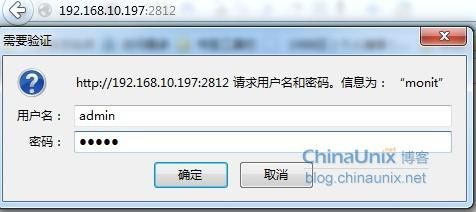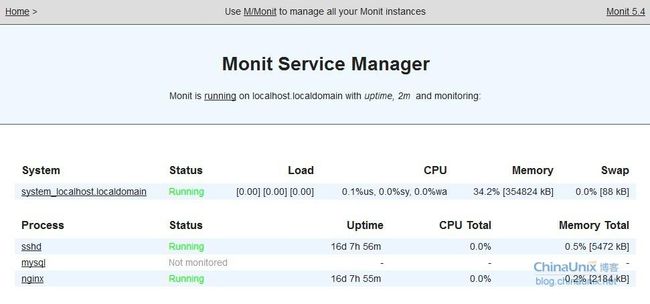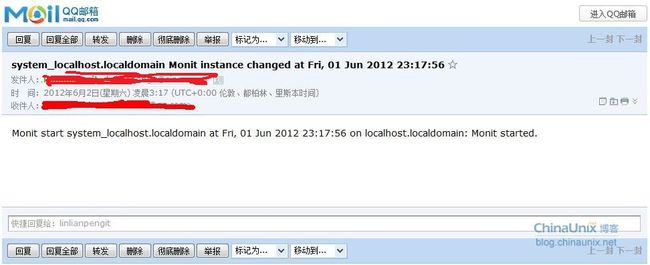1、安装Monit
Redhat、CentOS可以到:http://pkgs.repoforge.org/monit/ 下载对应位数rpm包安装。
Debian可以直接:apt-get install monit 安装。
官网下载最新版:http://mmonit.com/download/
源码编译安装:
相关依赖: yum install pam-devel
tar zxvf monit-5.7.tar.gz
cd monit-5.7
./configure --prefix=/usr/local/monit --sysconfdir=/usr/local/monit/etc
make
make install
mkdir -p /usr/local/monit/etc
cp monitrc /usr/local/monit/etc
chmod 600 /usr/local/monit/etc/monitrc
2、修改配置文件
CentOS用RPM包安装的话配置文件在: /etc/monit.conf;
Debian apt-get安装的话配置文件在:/etc/monit/monitrc;
源码编译在安装目录 /etc/monit.conf
下面是一个简单的例子,配置文件中已经包含了大量的例子,可以看配置文件参考。
set daemon 120 #设置检测时间
set logfile /var/log/monit.log #monit日志
set httpd port 2812 and # monit内置了一个用于查看被监视服务
use address 192.168.10.197 # 设置这个http服务器的地址或注释使用所有本机IP
allow 192.168.10.0/24 # 允许本地访问
allow admin:monit # 设置使用用户名admin和密码monit
set mailserver smtp.12320.tv port 25 USERNAME "zsxlmonitor" PASSWORD "123456" #(设置发送邮件的服务器及邮箱)
#制定报警邮件的格式
set mail-format {
from: [email protected]
subject: [From Monit]$SERVICE $EVENT at $DATE
message:Date:$DATE
ServerHost: $HOST
Item:$SERVICE
Problem: $DESCRIPTION.
Action:$ACTION
}
#指定邮件接收者
set alert [email protected] with reminder on 3 cycles #每3个周期发送一次警告
或者
set alert [email protected] #每个错误都发送警告邮件
##################### 监控实例 #####################
#检测sshd服务
check process sshd with pidfile /var/run/sshd.pid
start program "/etc/init.d/sshd start"
stop program "/etc/init.d/sshd stop"
if failed port 22 protocol ssh then restart
if 5 restarts within 5 cycles then timeout
#检测mysql服务
check process mysql with pidfile /usr/local/mysql/var/vpser.pid
group database
start program = "/etc/init.d/mysql start"
stop program = "/etc/init.d/mysql stop"
if failed host 127.0.0.1 port 3306 then restart
if 5 restarts within 5 cycles then timeout
#检测nginx服务
check process nginx with pidfile /usr/local/nginx/logs/nginx.pid
start program = "/etc/init.d/nginx start"
stop program = "/etc/init.d/nginx stop"
if failed host localhost port 80 protocol http
then restart
自定义脚本:
if failed host localhost port 80 protocol http then exec “/usr/bin/restart.sh”
配置中的pid及启动、关闭脚本的路径一定要是全路径,且参数一定要正确否则会造成无法正常检测或正常启动。
如果添加了http可以直接使用http://192.168.10.197:2812 进行管理。
可以看到监控服务的运行状态:
3、启动/停止Monit
/usr/local/monit/bin/monit 启动
/usr/local/monit/bin/monit quit 关闭
Optional action arguments for non-daemon mode are as follows:
start all - Start all services
start name - Only start the named service
stop all - Stop all services
stop name - Only stop the named service
restart all - Stop and start all services
restart name - Only restart the named service
monitor all - Enable monitoring of all services
monitor name - Only enable monitoring of the named service
unmonitor all - Disable monitoring of all services
unmonitor name - Only disable monitoring of the named service
reload - Reinitialize monit
status - Print full status information for each service
summary - Print short status information for each service
quit - Kill monit daemon process
validate - Check all services and start if not running
procmatch
4、参数配置语法
4.1 监控模块
监控性能[运行中的程序,需指定PID]
CHECK PROCESS
监控文件
CHECK FILE
CHECK FIFO
监控文件系统
CHECK FILESYSTEM
监控目录
CHECK DIRECTORY
监控主机
CHECK HOST
监控系统
CHECK SYSTEM
监控程序
CHECK PROGRAM
4.2 动作[action]
ALERT 执行报警动作
RESTART 执行重启[根据定义的start program和stop program,先执行stop,然后start]
START 执行启动[直接执行定义的start program]
STOP 执行关闭[直接执行定义的stop program]
EXEC 执行脚本[直接执行 “ ” 内指定脚本(全路径)]
UNMONITOR 停止监控
4.3 资源项目[RESOURCE]
--PROCESS
CPU([user|system|wait]) CPU明细
CPU CPU使用率<%>
TOTALCPU CPU使用率【含子进程】<%>
SWAP 交换分区使用< Byte, kB, MB, GB >
CHILDREN 子进程
MEMORY 内存使用< Byte, kB, MB, GB >
TOTALMEMORY 内存使用【含子进程】< Byte, kB, MB, GB >
LOADAVG([1min|5min|15min]) 系统负载
UPTIME 运行时间< "SECONDS", "MINUTES", "HOURS", or "DAYS" >
--FILE
SIZE 大小< "B","KB","MB","GB" >
Permission 权限
UID
GID
PID
PPID
TIMESTAMP 时间戳< "SECONDS", "MINUTES", "HOURS", or "DAYS" >
-- SYSTEMFILE
usage 已使用
SPACE 距离项存在[值]
INODE inode值<个/%>
--HOST
host [] 主机[IP、域名]
port [] 端口[值]
type [] 传输协议[TCP|UDP|TCPSSL]
protocol [] 服务协议[APACHE-STATUS DNS DWP FTP GPS HTTP IMAP CLAMAV LDAP2 LDAP3 LMTP MEMCACHE MYSQL NNTP NTP3 POP POSTFIX-POLICY RADIUS RDATE RSYNC SIP SMTP SSH TNS PGSQL]
The HTTP protocol supports in addition:
REQUEST
HOSTHEADER
CHECKSUM
The Apache-status protocol supports in addition:
logging (loglimit)
closing connections (closelimit)
performing DNS lookups (dnslimit)
in keepalive with a client (keepalivelimit)
replying to a client (replylimit)
receiving a request (requestlimit)
initialising (startlimit)
waiting for incoming connections (waitlimit)
gracefully closing down (gracefullimit)
performing cleanup procedures (cleanuplimit)
-- PROGRAM
status 程序执行状态
4.4 判断测量[TEST]
FAILED [RESOURCE] 项的值为错误
CHANGED [RESOURCE] 项存在变化
EXIST [项] 存在[项]
DOES NOT EXIST 不存在[项]
4.4 比较语法
"<", ">", "!=", "=="
"gt", "lt", "eq", "ne"
"greater", "less", "equal", "notequal" then 值
4.5 监测时间
EVERY [number] CYCLES
every 2 cycles #每2个周期监测一次
EVERY [cron]
every "* * * * *" 分 时 日 月 周,*所有 x-y表示X至y,“,”指定某个点
every "* 8-19 * * 1-5" #每周1至5,每天早上8点至晚上7点内,按周期间隔监测
NOT EVERY [cron] 用法与VERY [cron]相反
5、实例语法
1.系统性能
#监控系统性能,定义监控名称myhost
check system myhost
#如果1分钟内系统负载大于4,则执行报警
if loadavg (1min) > 4 then alert
#如果5分钟内系统负载大于2,则执行报警
if loadavg (5min) > 2 then alert
#如果总内存使用率高于75%,则执行报警
if memory usage > 75% then alert
#如果交换空间使用率大于25%,则执行报警
if swap usage > 25% then alert
#如果CPU(user)使用率高于70%,则执行报警
if cpu usage (user) > 70% then alert
#如果CPU(system)使用率高于30%,则执行报警
if cpu usage (system) > 30% then alert
#如果CPU(wait)使用率高于20%,则执行报警
if cpu usage (wait) > 20% then alert
2.硬盘监控
#监控文件系统:/dev/sdb1,定义监控名称为datafs
check filesystem datafs with path /dev/sdb1
#挂载、卸载文件系统,注意开启这个功能。
#start program = "/bin/mount /data"
#stop program = "/bin/umount /data"
#检测文件系统的权限不为660时,则停止监控
if failed permission 660 then unmonitor
#检测文件系统的UID不为root时,则停止监控
if failed uid root then unmonitor
#检测文件系统的GID不为disk时,则停止监控
if failed gid disk then unmonitor
#检测文件系统的空间使用率超过80%,则执行报警
if space usage > 80% for 5 times within 15 cycles then alert
#检测文件系统的空间使用率超过90%,则执行卸载文件系统
#if space usage > 99% then stop
#检测文件系统的inode使用数超过30000,则执行报警
if inode usage > 30000 then alert
#检测文件系统的inode使用率超过99%,则执行卸载文件系统
if inode usage > 99% then stop
3.文件监控
#监控文件:/data/mydatabase.db,定义监控名称为database
check file database with path /data/mydatabase.db
#检测文件系统的权限不为700时,则停止监控
if failed permission 700 then alert
#检测文件的UID不为data时,则执行报警
if failed uid data then alert
#检测文件的GID不为data时,则执行报警
if failed gid data then alert
#检测文件的时间戳大于15分钟时,则执行报警
if timestamp > 15 minutes then alert
#检测文件的大小如果大于100M,则执行脚本
if size > 100 MB then exec "/my/cleanup/script" as uid dba and gid dba
4.目录监控
#监控目录:/bin,定义监控名称为bin
check directory bin with path /bin
#如果目录权限不为755,则停止监控
# if failed permission 755 then unmonitor
#如果目录的UID不为0,则停止监控
# if failed uid 0 then unmonitor
#如果目录的GID不为0,则停止监控
# if failed gid 0 then unmonitor
5.进程监控
#监控进程,指定进程的pid文件:/usr/local/apache/logs/httpd.pid,定义监控名称为Apache
check process Apache with pidfile /usr/local/apache/logs/httpd.pid
start program = "/usr/local/apache/bin/httpd -k start"
stop program = "/usr/local/apache/bin/httpd -k stop"
#检测进程的CPU占用率高于60%时,则执行报警
if cpu > 60% for 5 cycles then alert
#检测进程的CPU占用率高于80%时,则执行重启
if cpu > 80% for 10 cycles then restart
#检测进程的总内存占用高于200MB时,则执行重启
# if totalmem > 200.0 MB for 5 cycles then restart
#检测进程的子进程数高于200个,则执行报警
if children > 200 for 3 times within 5 cycles then alert
#检测进程的子进程数高于500个,则执行重启
if children > 500 for 5 times within 15 cycles then restart
#检测进程5分钟内的平均负载大于10时,则执行停止
#if loadavg(5min) greater than 10 for 8 cycles then stop
#检测127.0.0.1的80端口如果超时[5s]、错误,则执行重启
if failed host 127.0.0.1 port 80 protocol http for 5 times within 10 cycles then restart
#检测访问http://127.0.0.1/check.php,如果返回内容不是”OK”,则执行报警
if failed url http://127.0.0.1/check.php
and content == 'ok'
then alert
#检测访问127.0.0.1:80//somefile.html如果错误,则执行重启
if failed host 127.0.0.1 port 80 protocol http and request "/somefile.html" then restart
#检测指定主机,发送请求,判断返回值,执行指令
if failed host 127.0.0.1 port 80
send "GET / HTTP/1.0\r\nHost: 127.0.0.1\r\n\r\n"
expect "HTTP/[0-9\.]{3} 200 OK"
then alert
#检测apache-status判断值,执行指令
if failed host 127.0.0.1 port 80 protocol apache-status
loglimit > 10% or
dnslimit > 50% or
waitlimit < 20%
then alert
#if failed port 443 type tcpssl protocol http with timeout 15 seconds then restart
#如果在5个周期内重启3次进程,则判断为超时
#if 3 restarts within 5 cycles then timeout
#depends on apache_bin
#group server
6.监控主机
check host myserver with address 192.168.1.1
if failed icmp type echo count 3 with timeout 3 seconds then alert
if failed port 3306 protocol mysql with timeout 15 seconds then alert
if failed url http://user:[email protected]:8080/?querystring and content == 'action="j_security_check"' then alert


